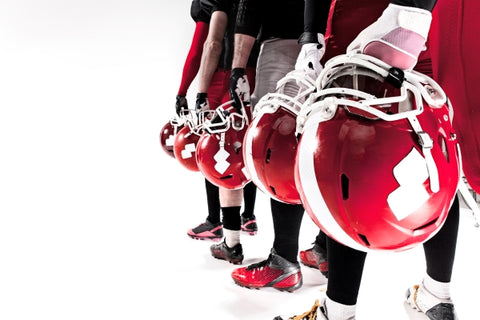The NFL Draft is an annual event that takes place over three days. It is a time when teams can improve their rosters by selecting the best college football players available.
The past three years, the NFL Draft has had an average of 8 to 10 million viewers throughout its three-day event. The NFL draft is the most popular major league sports draft in the United States, offering fans a first glimpse at the league’s newest talent. Apart from the entertainment factor, the draft is an important moment in a team’s season as it can shape their future.
Even if you’re not a fan of sports, you’ve probably heard of the National Football League (NFL). Annually, the NFL conducts a drafting event where teams select new players to join their organization. This can be a confusing process for fans, so in this post, we will break down how the NFL draft works. Who decides which players are chosen? How does the process work?
We will also discuss the importance of the draft and how it impacts teams and players. By the end of this post, you will have a better understanding of the NFL draft and what goes into it. Keep reading to learn more about the NFL draft!

The National Football League (NFL)
Before we talk about the NFL Draft, let us first give you an overview of what the NFL is. The National Football League (NFL) is a professional American football league consisting of 32 teams, divided equally between the National Football Conference (NFC) and the American Football Conference (AFC).
The NFL is one of the four major North American professional sports leagues, the highest professional level of American football in the world. The NFL was formed in 1920 as the American Professional Football Association (APFA) before renaming itself the National Football League for the 1922 season. They agreed to merge with the American Football League (AFL) in 1966, and the first Super Bowl was held at the end of that same season; the merger was completed in 1970.
Today, the NFL has the highest average attendance of any professional sports league in the world and is the most popular sports league in the United States. The Super Bowl is among the biggest club sporting events in the world and individual Super Bowl games account for many of the most-watched television programs in American history, all garnering tens of millions of viewers worldwide. The league's headquarters are located in Midtown Manhattan.
The Teams
The 32 teams that make up the NFL are all based in different cities and each team plays 16 games during the regular season. At the end of every season, six teams from each conference qualify for playoffs and compete for a chance to win the Super Bowl, which is widely considered as one of America’s biggest sporting events.
The teams in the AFC have included traditional powerhouses like the New England Patriots and Pittsburgh Steelers, but it also features newer franchises like Jacksonville Jaguars and Tennessee Titans. In the NFC, some notable franchises include Dallas Cowboys, Green Bay Packers, New Orleans Saints, and San Francisco 49ers.
The Players
The players who play in the NFL are some of the best athletes in their sport. Each team typically consists of 53 players on their roster with one head coach leading them to victory.
Over 2,000 players make up all 32 teams that comprise this powerhouse league and they come from all over—from high school to college to other professional leagues. Every year there is an annual draft when new players enter professional football by being drafted by one of these teams.
The Fans
It goes without saying that no sports league can be successful without its fans. From tailgating at games to wearing jerseys with your favorite player’s name on them to worldwide fantasy football leagues—the passion that fans have for their favorite team creates an atmosphere unlike any other sport where everyone can join together in celebration or commiserate together when things don't go their way. This camaraderie among fans is part of what makes following this sport so special.
NFL Management Council
The NFL Management Council works as an intermediary between players, teams, and the league. They protect the rights of both owners and players by working to ensure fair labor practices and collective bargaining agreements. In addition, they provide advice on legal matters related to player contracts, salary cap regulations, free agency rules, drug testing policies, franchise relocation guidelines, player discipline procedures, and more.
The council consists of representatives from each team who are responsible for handling these important issues. These representatives work closely with the league office to make sure all parties involved in any given issue come to a mutually beneficial agreement. It is their job to identify potential conflicts before they arise and propose solutions that will be accepted by all involved parties.
In addition to its core responsibilities outlined above, the council also provides financial assistance for retired players who need help with medical bills or other costs associated with retirement. They also provide educational opportunities for current players so that they can better prepare themselves for life after football. Finally, they are responsible for creating programs that promote health and safety among current players.
The NFL Management Council plays an important role in ensuring fair labor practices throughout the league. They act as a mediator between teams and players when disputes arise over contract negotiations or other personnel-related issues. Moreover, they provide much-needed financial support for former players who may not have adequate resources available once their playing days are over.
The NFL Draft
The NFL Draft is an exciting annual event for football fans around the country. Every year, college players from all over the U.S. are selected by the 32 teams in the National Football League (NFL) to join their team. But what is the NFL Draft, and how does it work? Let’s take a look at this crucial process that helps shape professional football in America each year.
The Process of Eligibility
To be eligible for the NFL Draft, players must meet certain criteria. Players must be at least three years removed from high school and have completed their college eligibility, or else they must declare themselves eligible by petitioning to enter the draft. Players are allowed to declare early after completing three seasons of collegiate play or when they turn 21. Teams have until May 7th each year to make their selections in order to give them adequate time to evaluate prospects and prepare for the draft.
The Format of Draft Day
The actual process of selecting players consists of seven rounds over two days – usually late April or early May – with teams taking turns making their picks in reverse order based on how well they did during that season’s regular season play. Each team has 10 minutes to make their selection during Rounds 1-2, seven minutes between Rounds 3-6, and five minutes for Round 7. If a team fails to make a selection before its allotted time has expired, it forfeits its selection and cannot make a pick until another round takes place.
Selection Process
The selection process for the NFL Draft consists of two parts — a nomination process and a selection round. During the nomination process, each team nominates a player from college or high school football who they would like to join their team.
Players can enter the draft either through an invitation from an NFL team's scout or through a declaration process that allows them to declare themselves eligible for selection by any team in the league.
The selection round begins with all 32 teams selecting one player each based on their nominations. This continues until each team has filled its roster with up to 10 new players for that season. During these rounds, teams may also trade selections with other teams if they choose to do so in order to gain more desirable players or positions in later rounds of the draft.
After all selections have been made, teams may also sign undrafted free agents who were not selected during any of the rounds but still meet certain requirements to play professionally in the NFL.
Signing Contracts
Once drafted and signed by an NFL team, players enter into contracts that guarantee them money and set out expectations by both parties regarding conduct on and off-field performance goals. These contracts are legally binding documents that outline salary details as well as bonuses if certain goals are achieved throughout their tenure with that particular team.
Players must sign these documents before they can begin practicing or playing games with their new team and once finalized become effective immediately upon the signing date or start date written into contract terms depending on when it is signed relative to the start date of the season, practice, or game.
The NFL Draft is an important event every year that helps shape professional football teams around America as they look toward building strong rosters ahead of upcoming seasons while also providing opportunities for college athletes looking to pursue careers in professional sports leagues like the National Football League (NFL).
It’s a complex but fascinating system built upon careful scouting and analysis by coaches and front-office personnel alike who make decisions based on years of experience at various levels of sports management across many different organizations worldwide throughout history! Understanding how it works can help fans appreciate its importance even more!
NFL Draft Rules
The NFL Draft is an exciting time for football fans. Every year, teams get to pick the best college football players in the nation and add them to their roster. However, it’s not as simple as just picking who you want. There are specific rules that govern how a team can pick players during the NFL draft. Let’s take a closer look at some of these rules.
The Order of Picks
The order of picks is determined by each team's record from the previous season; the team with the worst record has the first pick in every round, while the Super Bowl winner has the last pick in each round. This helps level out the playing field and gives losing teams a chance to improve their squad with higher-quality players than they might have had access to otherwise. Additionally, teams may trade their picks for other picks or for players already on another team's roster.
Time Limits
Each team is allotted 10 minutes per pick in rounds 1-3 and seven minutes per pick in rounds 4-7 of the draft. If they don't make their selection within this time frame, they must pass on that particular pick and will then be given two minutes once all other teams have made their selections before being forced to pass again. Teams are also allowed 30 seconds between picks if they want to take more time evaluating players before making a decision.
No Re-Picks Allowed
Once a team makes a selection in the draft, there is no going back; any mistakes made cannot be undone or corrected later on down the line. This means that teams have to be very careful when selecting a player so as not to make an error that could come back to haunt them later on—especially since there is no way for them to fix it after it's too late!
Seven Rounds
Most people know that there are seven rounds, but what happens during each round? Let’s break it down:
- Round One - This is when all the excitement begins! During this round, teams can select any player they want regardless of position or college. Teams that had a losing record in the previous season are given priority in this round as compensation for their poor performance.
- Round Two - In this round, teams still have a wide variety of positions to choose from; however, they must begin considering needs over wants. This means that if a team has an immediate need at linebacker, they will likely take a linebacker in this round instead of another position like offensive line or quarterback.
- Round Three - By now, most teams have addressed their more pressing needs and can start taking chances on players with higher potential who may not be ready to play right away but can develop over time into key contributors for the team.
- Round Four - This is when teams start looking for specific roles on their roster such as kickers, punters, and special-teams players.
- Round Five - This is where teams start selecting developmental prospects who may not make an impact immediately but could become valuable pieces in a few years.
- Round Six and Seven - These two rounds are typically used to fill out rosters with depth players who may never see quality playing time but can provide insurance should injuries occur during the season.
Draft Picks
NFL draft pick trading is one of the most exciting aspects of the process, as it allows teams to trade for picks with other franchises in order to get the players they want.
Drafted Positions
- Quarterbacks are one of the most important positions in football, and it’s no surprise that it’s also one of the most sought-after positions in the draft. Quarterbacks have always been highly touted, with several potential first-round picks.
- Wide receivers are always a popular choice in the NFL draft. They offer some of the best value in the draft because they can make an immediate impact on offense and help move the ball downfield quickly.
- Offensive linemen. Whether it’s tackles or guards, teams will be looking for players who can protect their quarterback from opposing defenses while opening up holes for running backs to exploit.
- Defensive Linemen. Similar to offensive linemen, defensive linemen play an integral role in any team’s success by providing pressure on opposing quarterbacks and clogging up running lanes for opposing running backs.
- Teams should pay close attention to defensive tackles, ends, nose tackles, as well as 3-4 outside linebackers depending on their defensive system preference. When evaluating these players, teams need to take into account not only size but speed and agility too.
Draft Prospects
NFL draft prospects are players who have been identified as having the potential to be selected in the NFL draft. Each year, hundreds of players declare for the draft, but only a handful are actually selected.
Most prospects are college football players, but some are also from other levels of football such as junior college or high school. The vast majority of prospects will never play a single down in the NFL, but for those who do, the rewards can be great.
A successful career in the NFL can lead to fame and fortune, and draft picks also receive a significant signing bonus just for being drafted. As a result, being an NFL draft prospect is a very prestigious and desirable distinction.
Compensatory Picks
Compensatory picks are additional selections given to teams in order to make up for lost free agents. If a team loses more free agents than it signs prior to the start of a season, then it is eligible for compensatory picks in the following year’s NFL draft. These picks are determined by a formula created by the league that takes into account factors such as salary and playing time with other teams.
How Many Compensatory Picks Can a Team Receive?
A team can receive up to four compensatory picks per season, but no more than one pick per round (the maximum number of rounds in the NFL Draft is seven). Anything beyond four picks is considered an exception and must be approved by 24 of 32 teams through a vote. This rule was put in place to prevent teams from stockpiling too many draft choices over multiple seasons.
How Do Compensatory Picks Impact the Draft?
Compensatory picks can have a significant impact on the outcome of an NFL Draft because they allow teams to add additional talent without having to give up any assets or make trades. This allows weaker teams to get stronger quickly and gives them an edge over other franchises that may not have been able to land high-value free agents due to their lack of cap space or other restrictions. It also allows teams with extra draft capital (due to trades) to maintain their advantage over competitors as well as help balance out the talent pool across all 32 franchises.
Compensatory Free Agents
Compensatory free agents (CFA) are an important part of the National Football League. They’re players who have been released by their former teams and then signed by a new team, with the intent of helping them balance out any lost talent due to free agency. The rules for compensatory free agents are complex, but understanding them can help you become a better fan and understand the machinations behind the scenes of the NFL.
Understanding Compensatory Picks
When a team loses a player in free agency, they are sometimes awarded “compensatory picks” in the following year’s draft as compensation for their loss. The picks are determined using a formula that weighs factors such as playing time, playing performance, salary, and contract size. In order to receive these picks, teams must have lost more or better-paid players than they gained in free agency during the previous season.
The selection process for compensatory picks follows the same rules as regular draft selections – teams select players one at a time until they reach their total number of picks (which is determined by how many compensatory picks they received). Teams may not trade compensatory picks, but they may be used to select multiple players in one round if desired. These selections may also be traded after being made, unlike regular draft selections.
Compensatory Free Agents
Compensatory free agents are players who were signed by another team after being released by their former club and before entering unrestricted free agency (UFA). These players are usually signed with the intent of balancing out any losses due to UFA signings or trades during that offseason.
When it comes to CFAs, teams must weigh several factors when deciding whether to sign them or not – including how much money they will cost against the team’s salary cap space, whether there is another player available who could fill that role for less money, and how much impact that player could have on their roster overall.
Additionally, teams must consider if there is any risk associated with signing that particular player – this could include injury risk or character concerns from past behavior off-the-field issues or even age considerations if the player is considered “older” than average for his position group.
Teams must also take into account what kind of compensation package they would receive from another team should CFA decide to sign elsewhere instead – this could include additional draft picks or cash compensation which would need to be weighed against other potential options available at that time.
It should also be noted that CFAs do not count against a team’s compensatory pick total since those picks can only be awarded based on UFAs signing with other clubs during a given offseason period rather than CFAs re-signing with their original club prior to becoming UFAs themselves.
NFL Compensatory Free Agents are an important part of managing an NFL roster effectively and efficiently while maintaining competitive balance within the league itself through proper utilization of resources like salary cap space and additional draft capital.
Understanding why teams choose particular CFAs over others can help fans make more educated decisions when evaluating moves made by their favorite teams throughout each off-season period going forward.
Trading
Trading in the NFL works differently than it does in other sports leagues. Instead of trading players directly for each other, teams will trade “draft capital”—essentially, future picks and selections that will be made at later drafts. This allows teams to move up or down on the board in order to get their desired player without having to give up too much value in return.
When Can Teams Trade Picks?
Teams are able to begin negotiating trades weeks before the actual draft takes place, though some trades may not become official until after the event has already started.
During the first round of the draft, teams have 10 minutes between each selection in order to decide on any possible deals that have been made prior to or during those 10 minutes. After this time has elapsed, any remaining trades must wait until after all selections have been made for that round before becoming official.
Related trades can also be made between rounds as long as both sides agree upon them before all selections for that round have been made official. Once all selections have been finalized for a particular round then no more trades can occur until after the start of the next round begins.
It's clear that there is quite a bit involved when it comes to trading picks during an NFL draft. Teams must carefully consider who they want and how much they are willing to give up in order to get their desired player while still maintaining enough assets for future drafts and trades.
Scouting
The goal of scouting an NFL Draft is to identify and select players who will have a long-term impact on your team. To achieve this goal, scouts must thoroughly evaluate each prospect so they can make an informed decision when selecting them in the draft. This includes researching and analyzing their performance on and off the field, as well as conducting interviews with coaches and teammates to get a better idea of their character and work ethic.
Scouts also need to be aware of any potential red flags that could affect a player’s future performance or ability to fit into a team's culture.
Another important aspect of scouting is understanding how teams value certain positions over others at different points in the draft process. For example, quarterbacks and wide receivers tend to be highly valued early on due to their game-changing potential, while offensive linemen usually don't come into play until later in the draft.
By understanding how other teams value certain positions, scouts can make educated decisions about which players they should target based on where they stand in relation to other teams' needs and wants.
College Football
The NFL draft relies heavily on college football, which provides a platform for young players to showcase their talent and compete against other top-level athletes. The performance of these players is then evaluated by scouts from various NFL teams in order to determine who will be drafted.
This connection between college football and the NFL draft was made even stronger in recent years with the introduction of scouting combines, where players are tested on physical skills such as speed, strength, and agility. This allows teams to really get to know potential prospects before making their decision at the draft.
Developing Athletes
College football is often seen as an important stepping stone toward playing in the NFL. In fact, many professional athletes credit their time spent playing in college as essential for preparing them for life in the pros.
College gives aspiring athletes the opportunity to hone their skills while also receiving guidance from experienced coaches and mentors. Not only does this help them develop athletically, but it also helps them build strong relationships with other players and coaches who can vouch for them when they make it to professional sports leagues like the NFL.
Training Practices & Strategies
College teams are constantly experimenting with new training practices and strategies as they look for ways to gain an edge over their opponents on game day. These strategies often trickle down into professional sports leagues like the NFL where coaches look for ways to improve their own teams' performance by adopting some of these new tactics used by college teams.
These can range anything from new drills to improved nutrition plans or even special plays designed specifically for specific situations during a game. By keeping an eye on what's working well in collegiate sports, coaches at all levels can capitalize on those ideas and incorporate them into their own playbooks with great success!
The Impact of College Rankings on Draft Picks
College rankings also play an important role in determining which players will be drafted and how high they will go in the selection process. Teams that have historically had successful football programs often have higher picks than those that haven’t performed as well. This is because NFL scouts know that these successful college programs produce better-prepared athletes who are more likely to excel at the professional level.
The Role of College Football in Preparing Players for the NFL
For players looking to make it to the NFL, college football can be an invaluable experience. Not only does it give them a chance to hone their skills in game situations, but it also allows them to develop their mental game-planning capabilities by studying their coaches' schemes.
In addition, it gives scouts an opportunity to see what kind of players they are up against. Furthermore, colleges have access to more advanced technology and training equipment than high schools do; this gives college players a distinct advantage over their high school counterparts when they try out for the pros.
Overall Impact of College Football on Professional Sports
In short, there is no denying that there is a relationship between college football and professional sports such as the NFL. By preparing players for playing in the pros, providing scouts with valuable information about potential prospects, and creating passionate fan bases that support both collegiate and professional teams alike, college football can have a significant impact on how successful any given sport is in any given season
After the NFL Draft
Being drafted into the NFL is one of the greatest honors an athlete can achieve. It marks the beginning of an incredible journey that will take them from rookie to veteran, and it’s a journey filled with hard work, dedication, and excitement.
The first few months are spent on learning. As soon as a player is drafted, they are exposed to their new team’s playbook and schedules. They must quickly learn intricate plays and understand how their team works together in order to be successful. This includes understanding formations, concepts, schemes, play-calling terminology, defensive calls, and much more. It can be overwhelming at times but it is essential if they want to make the most out of their opportunity.
The next step is all about showing up ready to compete and prove themselves on the field. Rookies must use the knowledge gained from studying their playbooks in order to showcase their skills during practice and games. During training camp and preseason games, players have a chance to show what they can do and prove that they belong on the team. After training camp wraps up it’s time for regular season games where rookies need to stay focused on executing what they have learned both physically and mentally on game day if they want to make an impact for their team this season.
Responsibilities
There are off-the-field responsibilities such as interacting with media personnel, attending fan events, volunteering in the community, hosting charity events or signings, and attending meetings with coaches or teammates - all activities aimed at connecting with fans and helping build relationships between players themselves while strengthening ties with those around them who support them in this endeavor. These activities help rookies learn how to become true professionals while also helping create positive relationships within their new home city/state/region which can positively affect them well beyond football season itself!
Becoming an NFL draft pick is just the start of a long journey filled with hard work and dedication for rookies, but if done right it could lead to great success in future seasons. By learning their playbook quickly, showing up ready to compete each day during practice or game days & engaging in off-the-field activities such as media interviews or volunteer work - rookies will be able to build professional relationships & grow within their organization while developing essential skills needed throughout their career.
Rookie salary cap
The National Football League has a salary cap system in place to ensure competitive balance throughout the league. This salary cap system affects all players in the NFL, including rookies.
How Does the Rookie Salary Cap Work?
The main purpose of the NFL’s rookie salary cap is to limit the amount of money that can be spent on rookies and keep them from being overpaid. This means that teams have more money available to spend on veterans who have proven themselves as reliable contributors to their team's success. The rookie salary cap also creates a more level playing field between teams with larger budgets and those with smaller ones.
The Impact of the Rookie Salary Cap
The rookie salary cap has had a major impact on both teams and new players entering the league. For teams, it ensures that they are not spending too much money on rookie contracts and allows them to maintain financial stability. For rookies, it prevents them from signing contracts with teams that may not be able to afford them.
This helps keep rookies from getting stuck with long-term deals they may not be able to live up to or may end up costing more than expected due to inflation or other factors. In addition, it helps ensure that all players get paid fairly based on their talent level and experience, which helps promote competitive balance within the league.
Conclusion
The NFL Draft is an exciting event filled with anticipation and drama each year as teams vie for top talent while making deals with other franchises along the way. While there are many complicated rules governing who gets chosen when most fans understand that it all boils down to getting the best possible players available so their favorite team can win more games going forward!
By understanding how NFL Draft works, fans gain even more insight into why certain decisions are made by their favorite teams which help them stay informed about what’s happening on game day. Along with that, rookies need to understand their responsibilities as they enter the league which includes learning the playbook quickly, showing up ready to compete each day, and engaging in off-the-field activities. Finally, understanding the salary cap system helps keep teams financially stable and ensures all players are paid fairly based on their talent level!
Overall, there is much more than meets the eye when it comes to becoming an NFL draft pick - but with proper preparation and dedication to succeeding, any rookie can become a success in this highly competitive environment. So don’t forget - no matter what stage of the process you’re currently at - make sure you stay focused and give it your all! Good luck!









